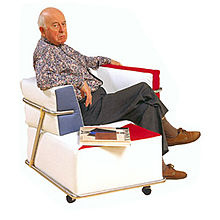Peter Smithson
Peter Smithson (born September 18, 1923 in Stockton-on-Tees , † March 3, 2003 in London ) was a British architect.
Life
Peter and Alison Smithson met while studying at the University of Durham and were married in 1949. In 1950 they founded their architectural practice APS in London , which they ran together until Alison Smithson's death in 1993. In 1953 they were instrumental in founding Team X , which had its first meeting during the CIAM IX architecture congress , from which they critically dissociated themselves. The founding members included the Smithsons Aldo van Eyck and Jacob Bakema (Holland), Georges Candilis and Shadrack Woods (France) as well as William & Jill Howell and John Voelcker . Important later members were Jerzy Soltan (Poland), Gier Grund (Norway), Ralph Erskine (Sweden), Stefan Wewerka (Germany) and Josep Antoni Coderch (Spain). They also co-founded the architectural trend of brutalism (English "new brutalism").
In 1982 Stefan Wewerka describes her work as follows:
“The new group was called ' Team X '. They met every two years to discuss common problems about urban planning. In the course of these discussions, Peter Smithson emerged more and more clearly as the real innovator in the field of settlement and urban development. His famous projects 'Capital Berlin' and the 'Golden Lane Project' gave the international conception of urban planning a new objective, as did the 'Cluster Studies' project. I remember the following remarks from conversations with the Smithsons, which I consider characteristic of them: 'Utopia is on the road', 'A town is the festival for the country' or 'let's give the bikes their distinct area to drive like our feet the necessary areas to walk '. "
After 1972, its reputation suffered significant damage when the Robin Hood Gardens residential complex proved to be both a technical and a social disaster. For a long time their only larger project after “Robin Hood Gardens” are a few buildings for the University of Bath , which they realized in the 1980s. Their importance remained limited to their activities as teachers and theorists, which contradicted their own claim to be primarily practicing designers and only secondarily theoreticians. In their book, Italian Thoughts , the Smithsons write of their own work:
“In a certain way, we continued our student life: alternating between writing and drawing essays, essays that are the result of insights gained during previous construction work […]. Seen the other way around, we [...] are completely connected to tradition with regard to the unity of reflection and construction. "
They only got another opportunity to do this type of work in the 1990s. From 1993 to 2002 they rebuilt and extended the so-called “witch house”, the home of Axel Bruchhäuser in Bad Karlshafen , Hessen . At the same time, they designed the company premises of the furniture manufacturer TECTA through architectural and landscaping modifications . The last major work by Peter Smithson, after the death of his wife in 1993, are the drafts for the new building of the Cantilever Chair Museum / TECTA-Archiv Lauenförde, which he did not see the inauguration in 2003.
buildings
- 1949–1954 Secondary School, Hunstanton , Norfolk
- 1955-1956: Sugden House, Watford
- 1959–1962: Upper Lawn Pavilion , Fonthill Estate, Tisbury, Wiltshire
- 1959–1964 The Economist Building , London
- 1966–1972 Robin Hood Gardens, Poplar , London
- 1993–2002 Hexenhaus, Bad Karlshafen , Germany
- 2002–2003 Kragstuhlmuseum / TECTA archive Lauenförde , Germany
Fonts
- Alison Smithson, Peter Smithson: Italian Thoughts. Observations and reflections on architecture. Vieweg, Wiesbaden 1996, ISBN 3-528-06111-1 .
- Alison Smithson, Peter Smithson, Ulrich Conrads, Peter Neitzke von Birkhäuser: Italian thoughts - further thought. Birkhäuser, Basel et al. 2001, ISBN 3-7643-6341-X .
- Alison Smithson, Peter Smithson: The Charged Void: Urbanism . The Monacelli Press, New York 2005, ISBN 1-58093-130-8 .
- Peter Smithson, Karl Unglaub: Flying Furniture. Verlag Walther König, Cologne 2000. ISBN 3-88375-405-6
- Alison Smithson, Peter Smithson: The Heroic Period of Modern Architecture . Wasmuth, Tübingen 1981, ISBN 3-8030-5041-3 .
- Georg Aerni, Bruno Krucker, Marie A. Lerjen: Complex habituality. (Complex Ordinariness). The Upper Lawn Pavilion by Alison and Peter Smithson. gta Verlag, Zurich 2002, ISBN 3-85676-103-9 .
- Peter Smithson, Hans Ulrich Obrist: Smithson Time. A dialogue. König, Cologne 2000, ISBN 3-88375-465-X .
- Alison Smithson, Peter Smithson: Changing the Art of Inhabitation. Artemis, 1998, ISBN 1-874056-37-4 .
literature
- Michael Kasiske: In the fairytale forest. Housing extension on stilts. In: Bauwelt. 11, March 12, 1999, 90th year.
- Claude Lichtenstein, Thomas Schregenberger: As Found - The discovery of the ordinary. Lars Müller publishing house, Baden 2001, ISBN 3-907078-40-3 .
- Michael Kasiske: Peter Smithson 1923-2003. Obituary. In: Bauwelt. March 12 / Stadtbauwelt 157, March 28, 2003, 94th year
Web links
- Literature by and about Peter Smithson in the catalog of the German National Library
- Student paper on A + P Smithson ( Memento from September 30, 2007 in the Internet Archive )
- Dirk Meyhöfer: deutschlandfunk.de: The secret of the cabinet door . Deutschlandfunk , Das Feature , June 20, 2014 (June 22, 2014)
Individual evidence
- ↑ Alison et Peter Smithson, Sugden House, Watford, Royaume-Uni, 1955–1956
- ↑ http://www.c20society.org.uk/botm/alison-peter-smithsons-upper-lawn-pavilion/ Alison & Peter Smithson's Upper Lawn Pavilion
| personal data | |
|---|---|
| SURNAME | Smithson, Peter |
| BRIEF DESCRIPTION | British architect |
| DATE OF BIRTH | September 18, 1923 |
| PLACE OF BIRTH | Stockton-on-Tees , England |
| DATE OF DEATH | March 3, 2003 |
| Place of death | London |




